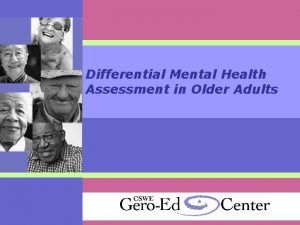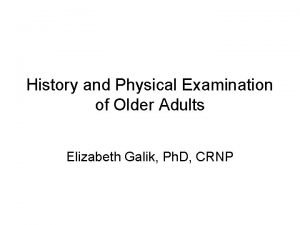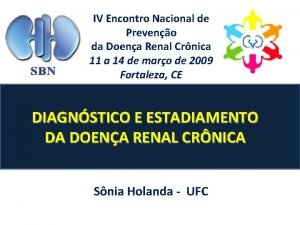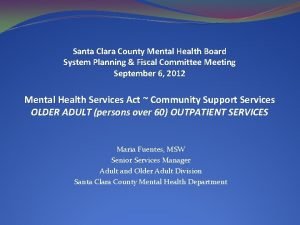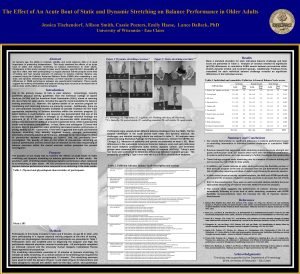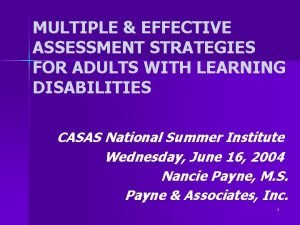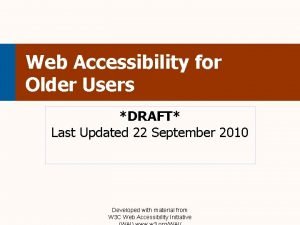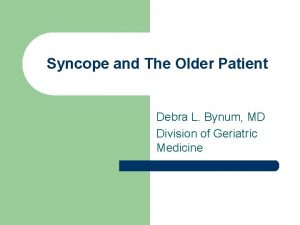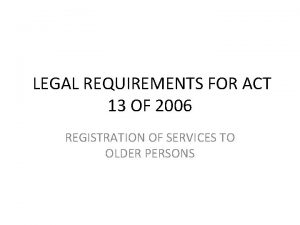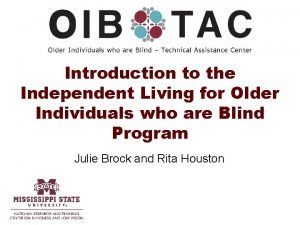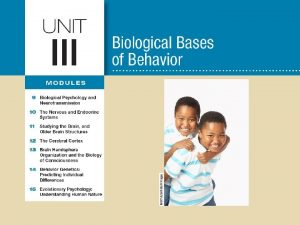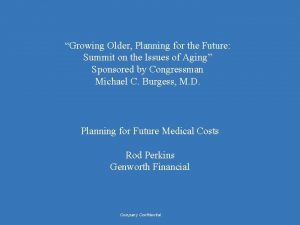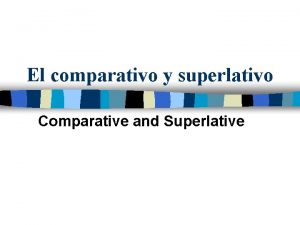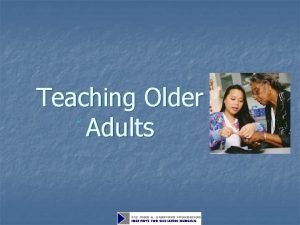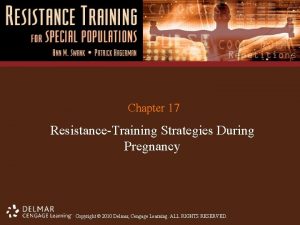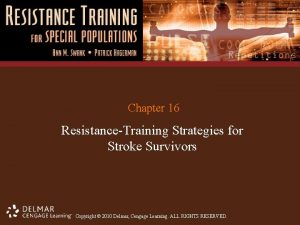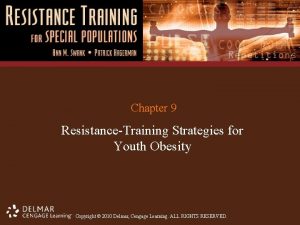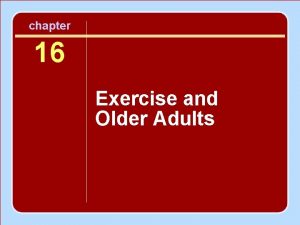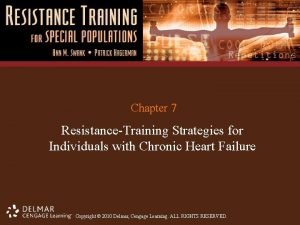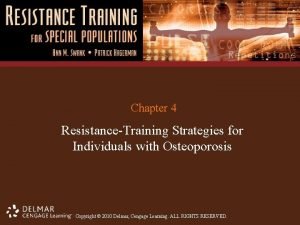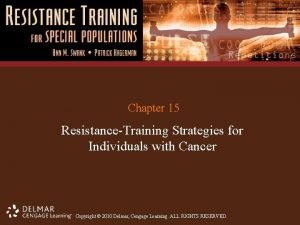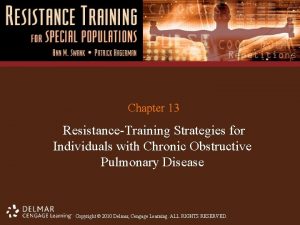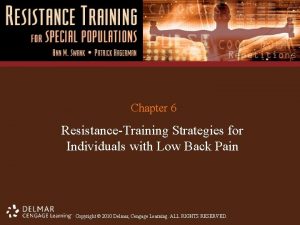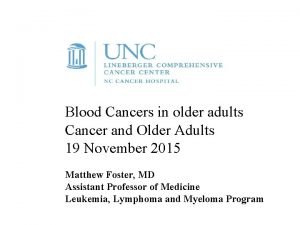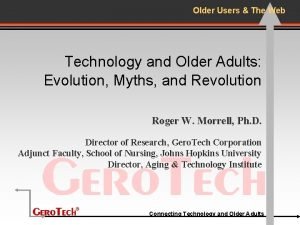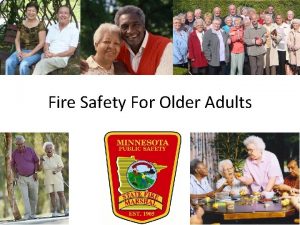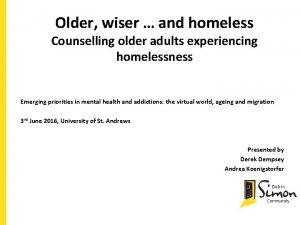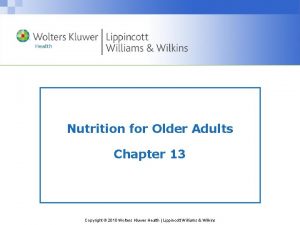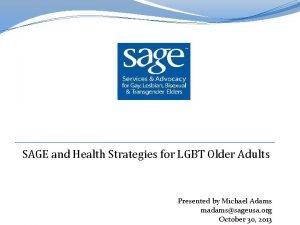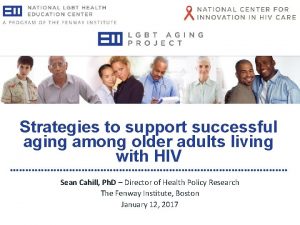Chapter 3 ResistanceTraining Strategies for Older Adults Copyright









































- Slides: 41

Chapter 3 Resistance-Training Strategies for Older Adults Copyright © 2010 Delmar, Cengage Learning. ALL RIGHTS RESERVED.

Advantages of Resistance Training • Helps modify aging patterns • Helps stabilize health profiles – Mitigates frailty • Helps preserve and (possibly) enhance functional capacity, vitality, and quality of life Copyright © 2010 Delmar, Cengage Learning. ALL RIGHTS RESERVED.

Obstacles to Resistance Training • Multiple chronic medical conditions • Limited access to appropriate programs or qualified instruction • Fear of injury • Logistical obstacles • Economic barriers Copyright © 2010 Delmar, Cengage Learning. ALL RIGHTS RESERVED.

Prevalence of Aging • More than 35 million Americans over age 65 – Approximately 12 percent of total population • By 2030, 70. 3 million adults over age 65 – More than 20 percent of population • Older adults susceptible to frailty, disease, and dependency Copyright © 2010 Delmar, Cengage Learning. ALL RIGHTS RESERVED.

Frail Older Adults Constitute • • 50 percent of all hospital care 80 percent of home care services 90 percent of all nursing home beds US spent approximately 66 percent of $585 billion on health care in 2000 on older adults Copyright © 2010 Delmar, Cengage Learning. ALL RIGHTS RESERVED.

Physiology of Aging • Pervasive loss of fat-free mass – Skeletal muscle • Increases in body fat • Cardiovascular changes Copyright © 2010 Delmar, Cengage Learning. ALL RIGHTS RESERVED.

Sarcopenia • Age-related loss of skeletal muscle mass and strength • Progressive atrophy of skeletal tissue • Rate of loss accelerates after age 50 • Results in functional limitations – Impaired activities of daily living Copyright © 2010 Delmar, Cengage Learning. ALL RIGHTS RESERVED.

Risks of Increased Body Fat • Predisposition to metabolic-based morbidities • Predictor of disability, physical limitation, declining mobility/quality, and higher mortality • Combined with sarcopenia, increases overall morbidity and mortality Copyright © 2010 Delmar, Cengage Learning. ALL RIGHTS RESERVED.

Cardiovascular Changes • Stiffening of large central arteries • Heart exerts more effort – Pushing blood downstream • Increased cardiac workload causes: – Exercise intolerance – Increased susceptibility to instability Copyright © 2010 Delmar, Cengage Learning. ALL RIGHTS RESERVED.

Inflammation • Caused by many non-cardiac diseases – E. g. , chronic obstructive pulmonary (COPD), infections, arthritis • Detriment to functional capacity in elderly • Visceral fat common source of systemic inflammatory peptides Copyright © 2010 Delmar, Cengage Learning. ALL RIGHTS RESERVED.

Benefits of Resistance Training • Allays muscle weakening/atrophy – Can stimulate muscle growth • Reduces body fat, inflammation, and catabolism • Increases function Copyright © 2010 Delmar, Cengage Learning. ALL RIGHTS RESERVED.

Benefits of Resistance Training • Diminishes frailty • Preserves and/or restores more youthful, generally healthier physical profile Copyright © 2010 Delmar, Cengage Learning. ALL RIGHTS RESERVED.

Positive Impact on Aerobic Power • Facilitates increases in overall physical activity • Enables safe initiation of physical activity • Increases posture, joint stability, balance, flexibility, and bone strength • Improves capacity for activities of daily living Copyright © 2010 Delmar, Cengage Learning. ALL RIGHTS RESERVED.

Positive Impact on Sarcopenia • • • Increases fiber size Increases muscle mass and intrinsic strength Mitigates oxidative stress Increases protective heat shock proteins Contributes to pattern of increased overall activity that reduces ambient inflammation Copyright © 2010 Delmar, Cengage Learning. ALL RIGHTS RESERVED.

Positive Impact on Body Fat • Fat reduction • Increased muscle mass leads to higher levels of physical activity • Reduced visceral fat mitigates associated risks for insulin resistance and hypertension Copyright © 2010 Delmar, Cengage Learning. ALL RIGHTS RESERVED.

Positive Impact on Body Fat • Enhanced insulin sensitivity in skeletal muscle decreases inflammation and helps weight loss Copyright © 2010 Delmar, Cengage Learning. ALL RIGHTS RESERVED.

Other Positive Impacts of Resistance Training • Bone mineral density – Increased muscle strength stimulates bone homeostasis • Helps mitigate osteopenia • Vasculature – Beneficial to vascular health Copyright © 2010 Delmar, Cengage Learning. ALL RIGHTS RESERVED.

Training Goals for Frail Adults • Slow progression of weakening/disability • Regain capacity for activities of daily living • Emphasize safety and behaviors conducive to long-term progression Copyright © 2010 Delmar, Cengage Learning. ALL RIGHTS RESERVED.

Training Goals for Frail Adults • Begin with basic, simple movements – – Warm-up and stretching Instruction on balance and breathing Low-intensity resistance using body weight Short sets • One to two sessions per week Copyright © 2010 Delmar, Cengage Learning. ALL RIGHTS RESERVED.

Training Goals for Frail Adults • Advanced – Add resistance tubing, ankle weights, and other weights over time – Increase repetition number before resistance Copyright © 2010 Delmar, Cengage Learning. ALL RIGHTS RESERVED.

Training Goals for More Robust Adults • Include strategies to achieve maximum increases in muscle mass, muscle strength, and function • High-intensity regimens achieve beneficial muscle and metabolic changes • Benefits among men and women similar Copyright © 2010 Delmar, Cengage Learning. ALL RIGHTS RESERVED.

Exercise Prescription Strategies for Older Adults • ACSM guidelines use Borg scale of perceived exertion • Intensity ranges from 12 to 19, two to three days per week, up to one hour • Older adults can maintain these goals with key refinements – Particularly when frail Copyright © 2010 Delmar, Cengage Learning. ALL RIGHTS RESERVED.

Exercise Prescription Strategies for Older Adults • Robust older adults can begin at lower intensities of 12 to 13 and then advance to 15 to 16 • Frail adults may advance to intensities of 12 to 13 Copyright © 2010 Delmar, Cengage Learning. ALL RIGHTS RESERVED.

Exercise Prescription Strategies for Older Adults • Emphasize muscles in lower and upper extremities that facilitate standing, walking, lifting, and reaching Copyright © 2010 Delmar, Cengage Learning. ALL RIGHTS RESERVED.

Exercise Choices • Exercise machines – Provide greater safety – Make it easier to control ROM Copyright © 2010 Delmar, Cengage Learning. ALL RIGHTS RESERVED.

Exercise Choices • Free weights – – Offer greater accessibility Provide cost advantages Require thorough teaching and monitoring May be difficult for frail older adults Copyright © 2010 Delmar, Cengage Learning. ALL RIGHTS RESERVED.

Factors Influencing Exercise Prescription • • • Time of day Proper clothing and footwear Appropriate warm-up and cooldown Static stretching for each muscle group Proper breathing – Avoiding/Minimizing Valsalva maneuver Copyright © 2010 Delmar, Cengage Learning. ALL RIGHTS RESERVED.

Factors Influencing Exercise Prescription • Rhythmic movements performed at moderate-to-slow, controlled speed through full ROM • Supervised training of proper technique • Length of sessions – Begin with short sessions – Only advance as stamina/comfort increase Copyright © 2010 Delmar, Cengage Learning. ALL RIGHTS RESERVED.

Factors Influencing Exercise Prescription • Use of unilateral movements to increase balance and decrease total amount of work • Allowance for rest, as needed • Use of Borg scale to gauge exercise intensity Copyright © 2010 Delmar, Cengage Learning. ALL RIGHTS RESERVED.

Effects of Cardiovascular Diseases on Exercise Prescription • Program must include: – Clinical assessment – Coordinated care with primary physician – Monitoring • Does not preclude participation in program Copyright © 2010 Delmar, Cengage Learning. ALL RIGHTS RESERVED.

Effects of Cardiovascular Diseases on Exercise Prescription • Typically safer than aerobic training due to slower heart rate • Contraindications – Signs/Symptoms of unstable cardiac conditions Copyright © 2010 Delmar, Cengage Learning. ALL RIGHTS RESERVED.

Barriers to Resistance Training • Fear of precipitating cardiac event or causing injury • Embarrassment over incontinence or lack of skill • Apprehension caused by hearing/visual impairments, cognitive slowing, and economic constraints Copyright © 2010 Delmar, Cengage Learning. ALL RIGHTS RESERVED.

Barriers to Resistance Training • • Lack of transportation Poor nutrition Lack of sleep Muscle soreness – Causing fear or apprehension Copyright © 2010 Delmar, Cengage Learning. ALL RIGHTS RESERVED.

Overcoming Barriers • Requires stepwise, individual approach • Apprehension – Education to prevent injuries – Seated exercises to help prevent falls Copyright © 2010 Delmar, Cengage Learning. ALL RIGHTS RESERVED.

Overcoming Barriers • Sensory impairment – – Visual aids and signs with large fonts Consistent room organization Proper lighting Loud and clear manner of speaking Copyright © 2010 Delmar, Cengage Learning. ALL RIGHTS RESERVED.

Overcoming Barriers • Economic – Most challenging barrier to overcome – Classes offered in senior centers • Help with transportation issues • Low-cost transportation options often unavailable to older adults Copyright © 2010 Delmar, Cengage Learning. ALL RIGHTS RESERVED.

Home-Based Exercise • Unsupervised • “Exercise & Physical Activity: Your Everyday Guide from the National Institute on Aging” Copyright © 2010 Delmar, Cengage Learning. ALL RIGHTS RESERVED.

Home-Based Exercise • Barriers to success: – Frail adults require personal instruction – Periodic reassessment necessary – Lack of emergency care Copyright © 2010 Delmar, Cengage Learning. ALL RIGHTS RESERVED.

Community-Based Exercise • Occurs in health or fitness center • Supervised • Social Copyright © 2010 Delmar, Cengage Learning. ALL RIGHTS RESERVED.

Advantages of Community-Based Exercise • Incorporates components of assessment, monitoring, and safety • Social reinforcement means higher adherence to routine • Achieves significant increases in lean mass and muscle strength • Better suited for frail older adults Copyright © 2010 Delmar, Cengage Learning. ALL RIGHTS RESERVED.

Successful Resistance Training • For older adults, requires: – Social support and positive reinforcement from friends, family, and physician – Comprehensive management strategy to maximize recruitment, increase teaching and safety, increase motivation, and minimize attrition • Review sample 24 -Week Program Copyright © 2010 Delmar, Cengage Learning. ALL RIGHTS RESERVED.
 Life is older older than the trees
Life is older older than the trees Mental health and older adults
Mental health and older adults Mental health and older adults
Mental health and older adults Altered cognition in older adults is commonly attributed to
Altered cognition in older adults is commonly attributed to Physical examination conclusion
Physical examination conclusion Older adults
Older adults Covids older adults
Covids older adults Older adults mental health
Older adults mental health Dynamic stretching for older adults
Dynamic stretching for older adults Assessment strategies for adults
Assessment strategies for adults Web accessibility for older users
Web accessibility for older users Taller stronger little sister
Taller stronger little sister Syncope in the older patient is
Syncope in the older patient is Td st annes
Td st annes Older persons act norms and standards
Older persons act norms and standards Intellectual development in older adulthood
Intellectual development in older adulthood Older individuals who are blind program
Older individuals who are blind program As people grow older
As people grow older Juan continued playing although he injured his knee
Juan continued playing although he injured his knee The brother of the prodigal son
The brother of the prodigal son Nipołomice
Nipołomice Downsizing and divesting older business
Downsizing and divesting older business Sos spelling for older students
Sos spelling for older students My rotten redheaded older brother
My rotten redheaded older brother Ajayan is ten years older than vijayan
Ajayan is ten years older than vijayan Module 11 studying the brain and older brain structures
Module 11 studying the brain and older brain structures Cost growing older
Cost growing older Lesson 2 a letter from an english friend
Lesson 2 a letter from an english friend Moses older sister
Moses older sister Menos comparative
Menos comparative The virtues of growing older
The virtues of growing older Sos spelling for older students
Sos spelling for older students Collective noun of sisters
Collective noun of sisters The wild swans at coole techniques
The wild swans at coole techniques Label
Label Who is maryam in the breadwinner
Who is maryam in the breadwinner Thunder cake plot diagram
Thunder cake plot diagram Older women's cohousing
Older women's cohousing Iso 22301 utbildning
Iso 22301 utbildning Typiska novell drag
Typiska novell drag Tack för att ni lyssnade bild
Tack för att ni lyssnade bild Vad står k.r.å.k.a.n för
Vad står k.r.å.k.a.n för


